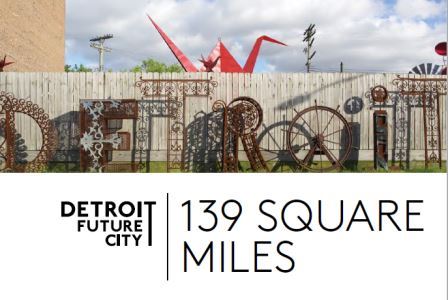Planning for the future in a city whose narrative has been defined by uncertainty is challenging.
Still, Detroit Future City took on the challenge, got input from more than 100,000 community members and adopted as a road map toward equitable and sustainable development by the Duggan administration. Now, it’s time for implementation, says Detroit Economic Growth Corp, executive director of DFC.

Implementation will align DFC’s core competencies in urban planning, community engagement, and technical problem-solving with the city’s development objectives, such as corridor development. DFC will also address cultural questions, an area Goss-Foster says she’s especially focused on with respect to small business growth.
“What we know is African American and Latino businesses are not growing at the same rate as Asian and white businesses, so there’s an equity issue here, and we’re not accepting (as an explanation) that they have different kinds of businesses,” she says.
Goss-Foster cites the importance of reshaping economic and cultural narratives around business to ensure the revitalized community more accurately reflects the demographic makeup of the city.
DFC spun off from the Detroit Economic Growth Corp.’s umbrella in 2015 and hs reorganized. Its recent organizational changes include the addition of new board members and the hiring of Tom Goddeeris, formerly executive director of Grandmont Rosedale Development Corp., brought on as the director of community and economic development. His efforts will address among others, the tricky balance in Detroit’s housing market, which is overwhelmingly dominated by single-family homes – about 65 percent of the city’s housing stock, or, around 270,000 structures.
DFC’s “139 Square Miles” report illustrates extensive data.
- More than a third of the structures in the city were built before 1939, meaning thousands of homes have seen the ill effects of deterioration made even worse by the city’s economic decline
- A preponderance of rentals (51 percent of all housing units in Detroit) means a challenge for thinking about equity and economic stability, something the Duggan administration has begun addressing through strategies like the new rental inspection ordinance
Brownfield remediation is a big focus as well, at a time when many residents wonder what will happen to the vacant factory at the end of their block.
Development projects pushing outside the limited space of downtown, as rental rates and land values skyrocket, mean such projects become increasingly feasible, due to greater demand.
While many Detroiters have heard of the “transformational brownfield credit,” a redevelopment financing mechanism pushed through in state legislation disparagingly known as the “Gilbert Bills,” owing to local promoter Dan Gilbert, smaller-scale projects and work outside downtown remains off the radar for many.
“There are 900 (vacant, industrial) properties throughout Detroit, which makes about six miles of the city’s land mass,” Goss-Foster says. “Only 12 of them are actually what would be considered the ‘dinosaur’ sites more than 100,000 square feet.”
The Packard Plant, Fisher Body Plant, Detroit Port Terminal, and others fit into this “dinosaur” category, with Fernando Palazuelo’s redevelopment of the Packard site being the largest proposed redevelopment of these.
Goss-Foster isn’t afraid of pushing the city and other institutions, saying DFC recognizes the need for strategy and products that help advance an equitable, sustainable Detroit for future generations.
“I have a finite role to, after five years, be able to say that we have laid the framework for the next 50 years,” she says.
Please click here for the framework plan or here for the executive summary.


